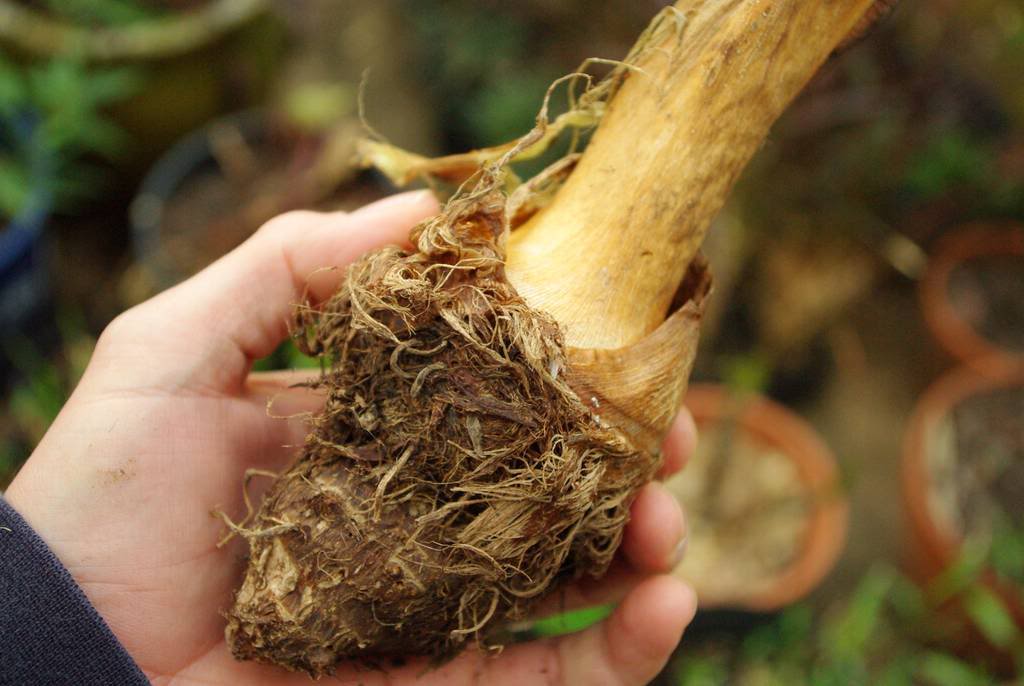An experiment with ears
>> Sunday, April 1, 2012 –
elephant ears,
overwintering
If you were reading my blog in the fall you may remember me talking about elephant ear tubers. I've grown various elephant ear varieties, and used various overwintering strategies. I've left them in pots in the garage, dug up the tubers and stored them dry, kept small plants alive inside under lights -- trying to find the strategy that involves the least effort on my part but allows me to have as many of these plants as I want come spring.
The normal Colocasia esculenta is dead-simple to overwinter, as the tubers store dry on a shelf with no issues. The black stem taro (Colocasia fontanesii) is a different story though, so I've been experimenting.
When I received my first black stem in a plant trade, the grower told me that he didn't think you could overwinter them as a tuber, because they really didn't form a good "bulb" like esculenta does. He kept his alive during the winter on a minimally-heated porch that never gets below freezing.
So my strategy with these the first winter was similar: keep a few small plants alive indoors under lights. That worked okay but I'd prefer to reserve my indoor plant table real estate for other plants, so two winters ago I kept some of the plants in the garage, while still bringing in some smaller ones under the lights.
The garage plants did very well, essentially freezing in time -- they didn't grow any, but didn't really die back either. They just stayed the same. In my garage they saw temperatures that typically got to about 40F (4C) as a low, and got very little light. I watered them a couple of times over the winter, which seemed to be plenty:
That's simple enough, but it still takes up quite a bit of room in the garage.
Last spring I bought a pre-bagged elephant ear that was supposed to be 'Black Magic', but ended up being another black stem -- disappointing except that from this I suspected that it might be possible to overwinter the black stem as a tuber. This past winter I gave it a try.
Here's what I tried:
- Put tubers into a closed tub on a bed of damp peat
- Put a tuber in a plastic bag and hung from a hook
- Left some tubers out on a shelf
- Kept some small tubers in their pots with no top growth
I still brought one small plant indoors and one bigger plant was moved into the garage as-is -- those were my backup plants using proven overwintering methods. If none of the other tubers made it through the winter, I'd have a couple of plants at least.
The results are in, and storing in the damp peat was the clear winner:
Second was storing in a plastic bag:
This probably only worked because the tuber remained moist where it touched the bag -- throwing some damp peat in the bag would probably have been better.
I'm not yet sure if the tubers that were left out on a shelf will make it, as they seem a bit desiccated:
I can't tell if the core of the tuber is okay in there, but it doesn't feel mushy so we'll see what happens.
Same for the tubers that were left in unwatered pots -- I don't know yet if they're still viable. I'll have to see if they wake up after being outside for a week or two. It's always so rewarding to plant what looks like a dead bulb and after a few days see a little push of green at the growing point:
So I'm concerned that some of these black stem tubers have perished, but I have no worries about the esculenta tubers -- I know every single one of these will grow:
These are the tubers you buy at pretty much any garden center that look a little like small coconuts -- mine don't have the stems removed, but they're the same plants.
I have so many of the esculenta -- literally buckets of them.
Whereas the black stem tubers seem to prefer to be slightly damp during storage, these do better when completely dry -- no chance of rotting then.
There are some really big ones too:
This post isn't about the esculenta though, it's about the black stem.
Now that I've found what seems to be an easy way to overwinter them in a relatively small amount of space (store tuber in some damp peat moss), who knows how many of these beauties I'll have next year!
.



















Cool! Glad you found a method that works for you - I'm sure gardeners in colder climates will find this helpful as well! I did a mini experiment with plumeria to see if keeping it in a pot made enough of a difference to warrant the space required. So far, it seems bare root is winning.
First, thanks for the reminder to check my stored tubers. I usually forget about them until they start sprouting in their bags.
And 2nd, congratulations, you won the drawing for my book "The Beginner's Guide to Growing Heirloom Vegetables. Shoot me a note with a mailing address and I'll get it out to you. Hope you enjoy it and I'll look forward to hearing what you grow this year.
I'm so glad to have found your post on the black stem elephant ears. I have many that just got bit by frost and I want to keep them for next year. Now I know how, thanks!
Jaime: these are really quite easy to overwinter. As long as they don't freeze they should be fine.
Thanks for the advice Alan.